When Marie and Pierre Curie discovered the natural radioactive elements polonium and radium, they did something truly remarkable– they uncovered an entirely new property of matter. The Curies’ work was the key to unlocking the mysteries of the atom, which was previously thought to be indivisible. Their research opened the door to nuclear medicine and clean energy, and it also led to the development of nuclear weapons.
Irène Joliot-Curie, her husband Frédéric, and many of their contemporaries were completely against the use of nuclear science as a weapon. They risked their lives to guard their work from governments hell-bent on destruction, and most of them, Irène included, ultimately sacrificed their health and longevity for the good of society.
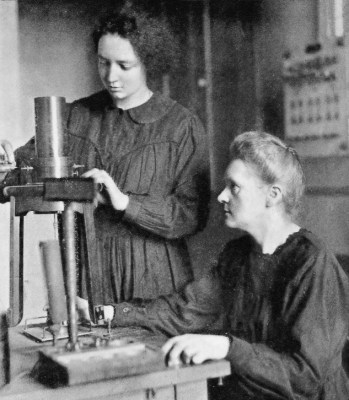
Childhood
Irène Curie was born September 12th, 1897 in Paris to Marie and Pierre Curie. She was a shy, serious child and quite attached to her mother. Irène idolized Marie from the start and spent her life trying to get closer to her. But the Curies spent long hours working in the lab. Once they won the Nobel Prize for discovering radium, Irene saw her mother even less.
Marie Curie was wary of the French educational system, which discouraged free thought in favor of rote memorization. So she and a few other parents formed a collective educational commune and took turns teaching each other’s children a diverse array of subjects from Chinese to sculpture. After a few years, the collective disbanded and Irène enrolled in a private school in Paris.
When Irène was eight years old, her father was trampled by the horses of a stagecoach and died instantly. Marie was so consumed by grief that she would avoid or abruptly end any conversation about Pierre, which frustrated Irène and further alienated her from her mother. Whenever they weren’t in school, Marie sent Irène and her younger sister Eve to stay with their aunt in a cottage by the sea while she worked in the lab and picked up the pieces of her life.
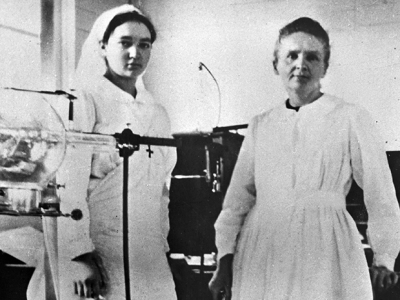
Futuristic Florence Nightingale
World War I erupted when Irène was seventeen. After a few months, she was finally reunited with her mother.
Marie threw herself into the war effort. She built a fleet of 20 mobile x-ray labs using donated vehicles, and powered the equipment with dynamos that ran off the cars’ engines. Irène took a nursing course and helped Marie teach doctors and nurses how to take x-rays of wounded soldiers. Many were skeptical of the technology until they saw for themselves how useful it could be to spot bone fractures and facilitate easy removal of bullets and shrapnel.
Irène traveled with her mother for two years before going back to school. She wasted no time, earning three degrees with distinction in just two years at the Faculty of Science in Sarbonne. Whenever she had time, she’d go back to the battlefield to help x-ray soldiers. Over the course of the war, it is estimated that more than one million soldiers received x-ray examinations thanks to the Curie women.
Lab Partners for Life
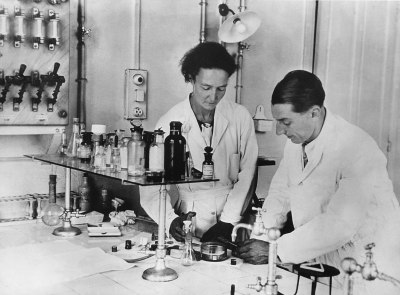
Irène became her mother’s assistant at the Radium Institute after the war. Here, she meets the friendly and outgoing Frédéric Joliot, chemical engineer in the making.
Marie hired him to work in the lab and assigned Irène to teach him the ropes of radioactive materials. They soon discovered a shared love of science, sports, and anti-war politics, and they were married a year later.
The 1930s is widely considered to be the golden age of physics. In a way, it’s the original global open source movement. Research teams all over the world were making new discoveries about the stuff of matter and its inner workings, and publishing their findings before the slides had dried in the rack. Not everyone was keen to share their methods, though. Irène had a bit of a professional rivalry with Lise Meitner, a physicist who discovered nuclear fission along with Otto Hahn.
Irène and Frédéric worked well together at the Institute which was one of the finest labs in the world. Both had education and experience in both physics and chemistry, and their differing approaches to problem solving were perfect complements. But success did not come quickly to the Joliot-Curies. It wasn’t for lack of research, though—they just didn’t interpret their data correctly.
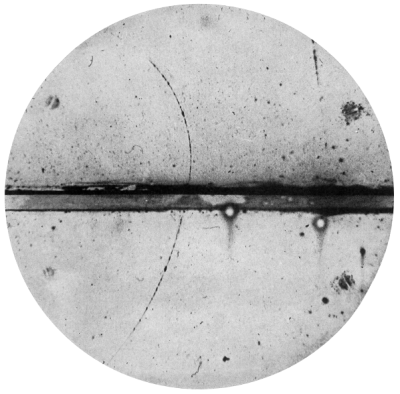
Neutrons, Positrons, and Perseverance
A few years prior, a pair of German physicists had bombarded beryllium with polonium particles and produced powerful radiation. The Joliot-Curies repeated the experiment and then carried it further by firing polonium at other substances. When the particles left a chunk of paraffin wax at one-tenth the speed of sound light, they knew they were on to something, but what? They believed they had seen gamma rays, and published an article outlining their findings.
Physicist Ernest Rutherford, whose gold foil experiments changed our understanding of atomic structure, wasn’t convinced. He argued that since gamma rays have no mass, it would be impossible for them to move heavy polonium particles so fast. He told his colleague, James Chadwick, to repeat the experiment. After ten days of work and sleepless nights, Chadwick concluded that the Joliot-Curies’ data conclusively proved the existence of the neutron, which Rutherford had proposed twelve years earlier. Chadwick snagged the 1935 Nobel Prize in Physics for this discovery, and the Joliot-Curies had to go skulking back to the drawing board.
Now the race was really on. The discovery of the neutron was a great boon to physics and allowed scientists to peer inside the nucleus. The Joliot-Curies used a Wilson cloud chamber to conduct experiments with polonium and saw tiny particles behaving strangely. Again, they published their findings without really understanding what they had seen. When American physicist Carl David Anderson repeated their experiments, he concluded that the Joliot-Curies had witnessed the positron in action. Again, the Joliot-Curies watched the Nobel Prize go to someone else for work they had done.
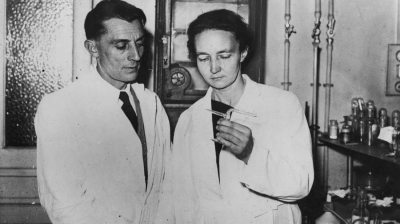
Eureka!
Irène and Frédéric kept searching for positrons by exposing different elements to polonium. One night, Frédéric repeated the experiment he and Irene had done using the Wilson cloud chamber, a chunk of polonium, and a sheet of aluminium foil. He had a Geiger counter nearby to measure radioactivity. When he was finished, he took the polonium away, but something strange happened. The Geiger counter kept clicking, sensing radioactivity. It was coming from the aluminium foil, which had absorbed alpha particles from the polonium and become artificially radioactive.
Frédéric ran from his downstairs lab to get Irene. He ran the experiment again without telling her what he was doing. Sure enough, the Geiger counter kept clicking after he took the polonium away and continued for several minutes. The foil had absorbed alpha particles from the polonium and become a temporarily radioactive form of phosphorus. After a few minutes, it decayed into silicon. There was no misinterpreting the data this time. The Joliot-Curies knew exactly what they’d done. They’d discovered artificial radioactivity, and cemented their place in history.
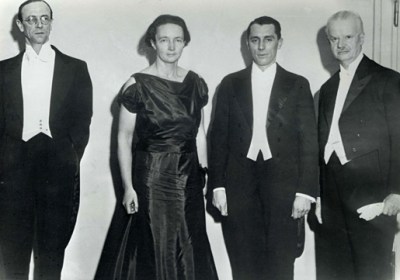
Nobels and Nobility
The Joliot-Curies won the Nobel Prize in Chemistry the following year, in 1935. By this time, the dangers of radioactive materials weren’t yet fully understood, but radiation poisoning had already taken many lives.
Of course, the power of nuclear science is two-sided coin. Radiation kills cancer, but it also causes cancer. Artificial radioactivity on a grand scale can create clean energy for all, but it can also decimate cities. Irene and Frédéric just wanted to build a reactor.
The Joliot-Curies had always been eager to share their work with the world, but when France went to war with Germany, they decided to reel it in. In 1939, they sealed their nuclear fission research in a vault at the French Academy of Sciences, where it stayed until 1949.
A year after Irène and Frédéric were married, doctors told Irène she had tuberculosis. This diagnosis hardly slowed her down throughout her life, though her condition was aggravated her work habits and by food shortages during the war. She continued to work in the lab and installed a cot so she could take breaks to rest. By the 1950s, Irène spent much of her time convalescing in the Alps. In January 1956, she was diagnosed with leukemia and died a few months later at age 58.
Irène Joliot-Curie’s story may be overshadowed by her famous parents, but her work provided the vital link between their work and the development of nuclear medicine. She deserves to be lauded for her undeniable contributions to science.















Why didn’t you just call it “nuclear energy” instead of the more contentious and less specific “clean energy”?
Well it is clean if you do it right. Too bad the people who run nuke power plants care about profit first and only care about clean inasmuch as it might interfere with profit.
Great article. But “Artificial radioactivity on a grand scale can create clean energy for all…” tells me that the author has never heard anything about nuclear waste we and many generations after us will have to worry about. And he did never hear anything about Harrisburg, Chernobyl, Fukushima and all the others. This is something I totally don’t understand.
The part you don’t understand is that these can still be used in a burner reactor which will destroys radioactive material. The part you don’t understand is that new reactor designs won’t generate fissile materials. The part you don’t understand is that congress is refusing to fund further nuclear research because it can’t be used to make weapons and fools like you are scared of all nuclear technology despite the facts.
The part you don’t understand is that everything you’re talking about is in the future and is not current reality.
I agree that massive investment in nuclear power technology and infrastructure is a great idea. But I’m not delusional about it.
There is recycling performed on nuclear waste. If I understand correctly… France does an excellent job at this paradigm of thinking and as in the Curie’s time can be a role model in advancing the systems performance capabilities and actual performance. I’m not sure why the U.S. struggles exactly.
Something like the waste the French produce from post recycling and maybe re-enrichment is very small in volume compared to the rest of the World and even the next largest nuclear players.
https://www.power-technology.com/features/managing-nuclear-waste-france-long-short-game/
Maybe this is something for more underground implementations… that is facilities to perform more critical thinking administration, processing and management of the nuclear materials. I feel… specifically focusing on the nucleogenesis and isotopic stabilizing using recycled, renewable and less energy intensive systems.
https://en.wikipedia.org/wiki/Nucleogenic
https://en.wikipedia.org/wiki/Nuclear_transmutation
I’m sure there is a way to use the heat from the system to further process the materials the system is designed to process. Why waste?
Not true, we’ve created and operated reactors capable of burning radioisotopes before, including Thorium Reactors.
Its very much been done.
See: Fast Breeder Reactors, of which multiple types have been tested and constructed.
https://en.wikipedia.org/wiki/Breeder_reactor
Well, we *could* instead burn fossil fuels like coal, and spread the radiation from its radioactive constituents all through the countryside.
Or we could pollute our waterways and landfills to manufacture and then dispose of vast farms of solar panels, to collect diffuse and intermittent sunlight. We would cover up good farmland with them, or build long power lines if we want to place them where we don’t live and farm. And build infrastructure to handle 5x the power we need, so we can store it for when the sun doesn’t shine. And build the expensive storage infrastructure to store that power for when we need it. And maintain all that infrastructure.
Or we could build windmills to collect the even more diffuse and fickle power from air currents. And store it. and transport it long distances. And likely will need to build backup power plants to supply power when the wind doesn’t blow for days and our batteries run out, thereby doubling the infrastructure capital costs.
All that effort and cost to extract a miserly amount of intermittent power from the air and sun, while destroying so much of our land.
Or if we got our act together we could build compact, reliable nuclear power plants that would heat cities, provide power, and desalinate water, while producing much less waste. However, they like running full-tilt because capital cost is high but incremental fuel cost is low, so they aren’t a good all-round solution.
So, instead, we could stop getting all cause-y about it, drop the rhetoric, and choose a sensible mix of baseload nuclear, wind & solar & hydro where cost-effective, natural gas turbines for peaking and co-gen, biomass and incineration for power-generating waste disposal, and hydro, batteries and flywheels for storage, load-leveling and grid stability.
Wait until we see the full cost of non-nuclear waste. Sure, these isotopes have quite a half-life, but what’s the half-life of a global equatorial desert? Of a completely dead ocean?
The metric that matters is deaths per watt. Everything else is emotional and sensationalist. We would have been better off with a million Fukushimas compared to where we’re headed.
We must use every tool at our disposal NOW to avert that catastrophe. We can’t afford to turn up our noses at imperfect solutions.
So what you are telling me is that nuclear can be clean in the future if certain technologies will be used (and will be working). At the moment nuclear power plants are producing waste that nobody is capable to store as long as necessary. Although we are not able to simply store the waste we keep the power plants running and producing more waste. Thousands of generations after us will have to deal with it. The technology of today uses only 0.7% of the uranium so there isn’t really THAT big amount of energy. Breeding reactors were stopped in Europe decades ago because of technical problems. And in addition there were serious accidents. Some of them were foreseen.
So what are the options? I totally agree that burning fossil fuels is not an option and we have to get rid of it as soon as possible. This means we have to get our energy from solar, wind, water and biomass. And an intelligent combination of them all. And some intelligent technology. And energy usage with maximized efficiency. And this all is possible. Solar electricity has become cheap within the last 15 years, wind electricity also is cheap. Reducing energy consumption by increasing efficiency is even cheaper. So what are we waiting for?
Don’t forget about the geothermal potential also… As well as on the contrary in regards to making other systems processes more efficient to produce “LESS LOSSES” in the form of heat typically. Ideally, the later systems implemented to not create as much noise and interference also. Waste… dealing with mitigating the risks/impacts of waste streams so they’re not turned into poisons too.
Solar energy is a joke in northern regions with less than 7 hours of sunshine in the winter. Also, when it gets really cold it seldom is windy, which debunks the wind alternative. Left are nuclear energy, coal, wood, water power. All have their individual perks and drawbacks but of the alternatives nuclear power when done right pollutes the air the least. End products are of course a pain in the behind to deal with. Coal ash tends to be tainted with heavy metals and sulphur. Wood ash is radioactive everywhere where the Tschernobyl fallout rained down. Water demands vast artificial lakes which in their own right is a total environmental disaster for anything upstream. There are no easy fix.
Seems with hydro there is a huge gap and disservice to humanity in not implementing more (or the required) fish hatcheries and other water foods to supplement the original natural surveyed production that if there aren’t systems to keep the natural hatching cycles of the food sources implemented in the utility implemented by design. Same goes for salt water systems… like the blue fin tune comes to mind with not being able to even hatch and/or develop in captivity. Areas of opportunity for sure and maybe those shareholders/stakeholders in the major seafood company stocks.
Youtube A.I. or something just suggested a video “Tuna Master Kuniaki Yoshizawa Serves an Entire Omakase out of Bluefin Tuna — Omakase” that noted their Bluefin Tuna are farmed raised. Looks like Bluefin is now capable of being farm raised too. So I better clarify… whatever over fished population can be farmed more. 90% of the natural resources have been depleted reads like can be replaced.
That got me thinking I also forgot to mention that coupled with Tech grad “Boring” like companies… there can be more underground or without boring… above ground water reserves terra formed with large geodesic or whatever the style of dome engineered to sustain longest term with the most cost effective natural resources… or maybe synthetic resources if non toxic over the lifecycle. Less or non-toxic seems best for the remediation/reclamation future concerns and plan.
Since the pump storage systems are so effective and if I understand correctly why our family property wasn’t converted into the system that was intended to be and was why was donated later to the State by Consumers Energy… I’ve wondered why there can’t be systems to eliminate the losses of hatchery fish (my understanding was the only concern for implementing… the DNR was losing their stock into the pumps intake) as well as domes or structure placed over the systems to create more habitat above the water storage area and keep the systems underground. Seems win-win for natural and domesticated resources.
Seems these systems can have modifications/hacks made to integrate fish farming also.
https://en.wikipedia.org/wiki/List_of_pumped-storage_hydroelectric_power_stations
Another interesting storage system that looks effective though seems more challenging and might be a similar interesting long term feet and is better suited for further underground deep salt or whatever ideal geology mines are the compressed air energy storage systems: https://en.wikipedia.org/wiki/Compressed_air_energy_storage
I think a huge benefit to humanity would be to reduce the losses in the power line transmissions. Not sure if this is a way… though seems like my vision for nuclear power generation systems to go underground… other utility related systems can go underground too. Seems like an interesting mass energy balance project for a serious engineer to think outside the box for longest terms implementation and least toxic life cycle impact to mitigate risk.
https://en.wikipedia.org/wiki/List_of_energy_storage_projects
Interesting is this article I just noticed… however… keep in mind how many nuclear bombs were exploded in the ocean too and maybe factoring in magnitude.
http://theterramarproject.org/daily-catch/global-warming-heats-oceans-at-rate-equivalent-to-atomic-bomb-exploding-every-second/
Still… seems whether green house or only solar cycle… there is something heating the planet up. If green house effect… then nuclear wouldn’t be as polluting if following my totally advocated nuclear submarine module approach to keep all the systems underground or at sea… ultimately ideally installed for the majority of their life cycle in quarantined underwater dampened locations.
All this space explorations investment and we’re neglecting underwater development and not just combined with underground… underground development alone for the most toxic systems life-cycles.
Maybe we can even develop nuclear processing on Mars or in space… transmutate junk on a sun pass. Keep the hottest processing off the planet?
Nuclear is far, far less polluting.
For instance: Chernobyl is a blossoming wildlife zone now, most of the areas outside of the reactor are very safe.
Compare that to strip mined areas for coal production, or oil spill areas.
For the energy density of nuclear, there’s very little that can beat it, and is a valuable tool in fighting climate change due to its footprint and output.
I agree completely when regulated, administrated and maintained throughout the whole life cycle of the system. Definitely, a way better than any other system for distributing energy. I feel the systems can go underground and preferably quarantined underwater to be even safer and relieve concerns from opponents. Wouldn’t be a bad industry either to have the dockyards or marinas above where the existing shoreline systems can be remediated for more productive above ground activity… even if wildlife. More nuclear power plant implements would equal less losses on power lines also in the form of heat and EMS pollution.
Don’t forget about the coal mines and gas wells that still burn underground to this day if I understand correctly.
https://en.wikipedia.org/wiki/Darvaza_gas_crater
https://en.wikipedia.org/wiki/Centralia_mine_fire
There’s always an appropriate XKCD https://xkcd.com/1162/
We just need to move to generation IV reactor designs such as molten salt reactors that burn most of the long lived actinides that makes nuclear waste dangerous for millennia.
There’s enough thorium to power civilization for over 1000 years.
“After ten days of work and sleepless nights, Chadwick concluded that the Joliot-Curies’ data conclusively proved the existence of the neutron, which Rutherford had proposed twelve years earlier.”
That is… not what happened. The Joliot-Curie observation was just that the radiation from polonium striking beryllium could eject protons of very high energy from something containing hydrogen. That could be explained by gamma rays, and that’s what they proposed – although the energy would have to be very high for the nuclear processes expected. But it’s possible, which is what Chadwick said in his paper on the discovery of the neutron: “It must, of course, be admitted that this argument is based on the hypothesis that the nuclei are made as far as possible of alpha particles [..] this assumption is supported by the evidence from experiments on artificial disintegration, but there is no general proof.”
So Chadwick performed additional measurements on *other* elements being ejected. Chadwick didn’t just repeat the Joliot-Curie’s experiment. He set up an apparatus and measured the effects on lithium, beryllium, boron, carbon and nitrogen. From that,Chadwick actually *measured the mass of the radiation emitted* as 1.15*proton mass, +/- 10%.
The Joliot-Curie experiment was important for the discovery of the neutron, but it wasn’t actually the discovery.
Bleah, correcting myself, he actually measured the neutron mass to be 1.0067 (+/- 0.001 or so) amu. Forgot there’s a later calculation in that paper.
I found the time travel interesting.
Chadwick gets the Nobel prize in physics in 1935. Our heroic pair return to their experiments, discover artificial radiation AND travel back in time to get the 1935 Nobel prize – in chemistry.
Henri Becquerel was the first to uncover radioactivity, but in 1934 the Joliot-Curies were the first to provide chemical proof of atomic transmutation and atomic fusion, which is really a great proof. pardon the character problems, source: Curie, Ir�ne, and Fr�d�ric Joliot. “S�paration chimique des
nouveaux radio�l�ments �metteurs d��lectrons positifs.” Comptes
rendus 198 (1934):
559-561. http://archive.org/details/ComptesRendusAcademieDesSciences0198 {Comp
tesRendusAcadmieDesSciences-Tome198-Janvier-juin1934_text.pdf}
Some props to Ernest Rutherford (no way disregarding the others… Kathy Love Physics previous video is regarding Madame Curie… noting her daughter also):
https://www.youtube.com/watch?v=IVngNa_mAaw
another interesting theory is that the so-called neutron may only be a hydrogen atom- the claimed difference is a very subtle one and seems doubtful in my humble opinion
Except that hydrogen atoms are not radioactive and neutrons are.
In fact, neutrons decay into hydrogen atoms…which unlike neutrons, can be ionized and have a spectrum. That’s not subtle at all. https://en.wikipedia.org/wiki/Free_neutron_decay
I work with neutrons….and hydrogen (all 3 isotopes).
…I’m gonna disagree on that, because Hydrogen is a bound state, and a free neutron is not, and it wouldn’t decay AND gain a proton and an electron.
https://physics.stackexchange.com/questions/7610/what-is-the-difference-between-a-neutron-and-hydrogen
“Yes, it can happen but very, very infrequently. The main problem is that there is a lot of kinetic energy left over after the decay and the electron and proton don’t stay around long enough to bind into a stable hydrogen atom. Matters are further complicated by the fact that there is also an electron anti-neutrino involved in the reaction. n -> p + e- + vbar. Since the binding energy of an electron in a hydrogen atom is only 13 eV (electron Volts) and the kinetic energy released in the decay is over 700 million eV the electron and proton tend to just fly apart. The anti-neutrino, being electrical neutral and weakly interacting, isn’t involved in the final state. It just carries off some of the kinetic energy. From time to time the neutrino will carry off enough energy to leave the electron and proton relatively at rest. In that case they can form a hydrogen atom. Experiments have been performed looking for this effect. It has been observed but seems to occur on average 4 times out of one million neutron decays. ”
Okay, it does happen, but very infrequently, I stand corrected
https://van.physics.illinois.edu/qa/listing.php?id=1207
” energy released in the decay is over 700 million eV ”
Dude. How can we take you seriously if you can’t keep orders of magnitude straight? THINK. 700 MeV is the mass of 1400 electrons! How about 700 keV?
“by firing polonium at other substances. When the particles left a chunk of paraffin wax at one-tenth the speed of sound, …”
Hunh? Even thermal (i.e., cold, slow) neutrons go about 6 times the speed of sound — pretty darned leisurely for subatomic particles. I can’t imagine what it would take to slow them down by another factor of 60. Run them through frozen hydrogen?
What does the source material actually say, Kristina? (a tenth the speed of light?)
Maybe the caption should read first image of a positron rather than image of first positron. But if I am wrong, wow!
I also spotted that. To get an “image of the first positron” you’d have to go back in time to shortly after the big bang.
s/Sarbonne/Sorbonne/
Sorbet!
Yes it should be Sorbonne…
What is artificial radioactivity?
Well, it is sort of like synthetic radioactivity, with fewer calories, but tastes better!
Transmutation is the proper term.
Very good, informative, well written. The article, that is.
More needs to be written, and known about, Irène Curie.